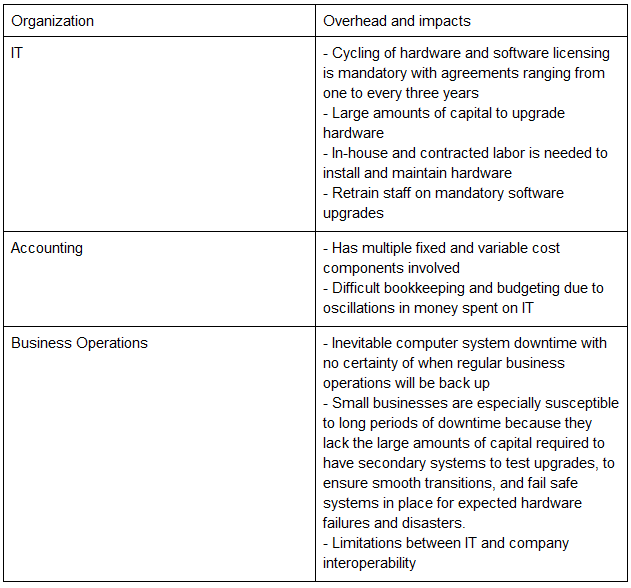Which is better – traditional IT infrastructure or the cloud? In this article we look at the pros and cons of both options, for any founder out there weighing up the different possibilities.
You probably already know that organizations make enormous investments towards in-house IT infrastructure. The total cost of owning and managing hardware and software is extremely expensive for any business, especially small to medium-sized enterprises just entering the market. IT departments find themselves with tighter budgets, thanks to ‘La Crisis’, and are constantly striving to reduce TCO, or Total Cost of Ownership, in order to keep the lights on and their jobs intact. Accomplishing this is especially difficult without sacrificing a lot of time that the IT department doesn’t have to spare, or money a company does not want to spend in order to hire consultants to do the work. However, many companies are now turning to cloud solutions because they are cost effective and an agile, scalable IT model that can service a full spectrum of business needs. As a result of significantly reducing its TCO, a company will not only be able to afford to turn on the lights everyday but focus its newly available resources, which are time and money, on innovation, research and development. How’s that for gaining a competitive edge?
In the case of start-ups, this means a lower cost of entry into the market. Think about all the start-ups that wouldn’t exist if they needed 10k just to get started. But wait, you’re probably saying, “Ya, ya…I hear about the cloud all the time, but I still do not know what it is!” Well, in this article I’m going to start off by explaining the implications of a traditional IT infrastructure within the context of the business environment.
In the second part of this article, we’ll break down the different components of a cloud environment and list some advantages and disadvantages associated with adopting cloud solutions. By the end of the article, you should have a pretty good understanding of how a traditional in-house setup compares to an outsourced cloud model.
Traditional IT Infrastructure
The traditional in-house IT model is very resource-intensive just to sustain day-to-day operations, which is not ideal for small businesses or start-ups.
Enterprises of varying size and complexity will benefit from a cloud solution. However, small firms that do not require a high level of customization will notice cost benefits right away.
Per the table above, it is clear that there are major financial costs associated with having a company-owned IT infrastructure on even the most basic level. The benefits associated with adopting an outsourced IT infrastructure are quickly noticed with smaller companies, due to the low cost of entry to market, fewer amount of resources required to meet and maintain IT demands, and the ability to adapt to new technologies on a company-wide level as a result of having fewer employees.
The table below summarizes business expectations contrasted with challenges faced by IT and the business impacts.
However, I do want to acknowledge some of the advantages of in-house systems, with security being at the top of the list. If a company’s data is stored on third party servers, it is subject to the cloud provider’s standards and not to those of the company. However, cloud providers are addressing these concerns and making it easier for companies to test and audit for security vulnerabilities. Also, in-house IT resources give you greater control over your applications and data. This, however, is easily mitigated by using cloud solutions that have open software standards, which allow a company to hire its own team of developers to customize per their specific needs.
To read the second part of this article, click here.
By the way: If you’d like to stay up-to-date regarding startup news and interesting opportunities, make sure to subscribe to our free weekly EU-Startups Newsletter.







[…] the first part of this article I started off by explaining the implications of a traditional IT infrastructure within the context of the business environment. In this second part, I’ll break down the […]
[…] off by explaining the implications of a traditional IT infrastructure within the context of the business environment. […]